Dipole and Convergent Single-Well Thermal Tracer Tests for Characterizing the Effect of Flow Configuration on Thermal Recovery
Abstract
1. Introduction
2. Methodology
2.1. Field Site
2.2. Experimental Setup
2.3. Conceptual Scheme of the Flow Configurations
2.4. Calibration and Data Processing
3. Results
3.1. Temperature Breakthrough of Experiment III
3.2. Characterization of Heat Losses from the Injection Tube During the Heat Injection Test
3.3. Data Processing Using Karthunen–Loève Transform
3.4. Comparison of the Thermal Breakthroughs
4. Discussion and Conclusions
Author Contributions
Funding
Acknowledgments
Conflicts of Interest
References
- Colombani, N.; Giambastiani, B.M.S.; Mastrocicco, M. Combined use of heat and saline tracer to estimate aquifer properties in a forced gradient test. J. Hydrol. 2015, 525, 650–657. [Google Scholar] [CrossRef]
- Hermans, T.; Wildemeersch, S.; Jamin, P.; Orban, P.; Brouyere, S.; Dassargues, A.; Nguyen, F. Quantitative temperature monitoring of a heat tracing experiment using cross-borehole ERT. Geothermics 2015, 53, 14–26. [Google Scholar] [CrossRef]
- Somogyvari, M.; Bayer, P.; Brauchler, R. Travel-time-based thermal tracer tomography. Hydrol. Earth Syst. Sci. 2016, 20, 1885–1901. [Google Scholar] [CrossRef]
- Wagner, V.; Li, T.; Bayer, P.; Leven, C.; Dietrich, P.; Blum, P. Thermal tracer testing in a sedimentary aquifer: Field experiment (Lauswiesen, Germany) and numerical simulation. Hydrogeol. J. 2014, 22, 175–187. [Google Scholar] [CrossRef]
- De La Bernardie, J.; Bour, O.; Le Borgne, T.; Guiheneuf, N.; Chatton, E.; Labasque, T.; Le Lay, H.; Gerard, M.F. Thermal attenuation and lag time in fractured rock: Theory and field measurements from joint heat and solute tracer tests. Water Resour. Res. 2018, 54, 10053–10075. [Google Scholar] [CrossRef]
- Anderson, M.P. Heat as a ground water tracer. Ground Water 2005, 43, 951–968. [Google Scholar] [CrossRef]
- Wildemeersch, S.; Jamin, P.; Orban, P.; Hermans, T.; Klepikova, M.; Nguyen, F.; Brouyere, S.; Dassargues, A. Coupling heat and chemical tracer experiments for estimating heat transfer parameters in shallow alluvial aquifers. J. Contam. Hydrol. 2014, 169, 90–99. [Google Scholar] [CrossRef]
- Saar, M.O. Review: Geothermal heat as a tracer of large-scale groundwater flow and as a means to determine permeability fields. Hydrogeol. J. 2011, 19, 31–52. [Google Scholar] [CrossRef]
- Molz, F.J.; Melville, J.G.; Parr, A.D.; King, D.A.; Hopf, M.T. Aquifer thermal-energy storage—a well doublet experiment at increased temperatures. Water Resour. Res. 1983, 19, 149–160. [Google Scholar] [CrossRef]
- Sauty, J.P.; Gringarten, A.C.; Fabris, H.; Thiery, D.; Menjoz, A.; Landel, P.A. Sensible energy-storage in aquifers: 2. Field experiments and comparison with theoretical results. Water Resour. Res. 1982, 18, 253–265. [Google Scholar] [CrossRef]
- Ma, R.; Zheng, C.M.; Zachara, J.M.; Tonkin, M. Utility of bromide and heat tracers for aquifer characterization affected by highly transient flow conditions. Water Resour. Res. 2012, 48. [Google Scholar] [CrossRef]
- Robert, T.P.C.; Bolly, P.-Y.; Koo Seen Lin, E.; Hermans, T. Heat as a proxy to image dynamic processes with 4D electrical resistivity tomography. Geosciences 2019, 9, 414. [Google Scholar] [CrossRef]
- Klepikova, M.; Wildemeersch, S.; Hermans, T.; Jamin, P.; Orban, P.; Nguyen, F.; Brouyere, S.; Dassargues, A. Heat tracer test in an alluvial aquifer: Field experiment and inverse modelling. J. Hydrol. 2016, 540, 812–823. [Google Scholar] [CrossRef]
- Chatelier, M.; Ruelleu, S.; Bour, O.; Porel, G.; Delay, F. Combined fluid temperature and flow logging for the characterization of hydraulic structure in a fractured karst aquifer. J. Hydrol. 2011, 400, 377–386. [Google Scholar] [CrossRef]
- Drury, M.J.; Lewis, T.J. Water-movement within lac-du-bonnet batholith as revealed by detailed thermal studies of 3 closely-spaced boreholes. Tectonophysics 1983, 95, 337–351. [Google Scholar] [CrossRef]
- Pehme, P.E.; Parker, B.L.; Cherry, J.A.; Greenhouse, J.P. Improved resolution of ambient flow through fractured rock with temperature logs. Ground Water 2010, 48, 191–205. [Google Scholar] [CrossRef]
- Bense, V.F.; Person, M.A.; Chaudhary, K.; You, Y.; Cremer, N.; Simon, S. Thermal anomalies indicate preferential flow along faults in unconsolidated sedimentary aquifers. Geophys. Res. Lett. 2008, 35. [Google Scholar] [CrossRef]
- Ge, S.M. Estimation of groundwater velocity in localized fracture zones from well temperature profiles. J. Volcanol. Geotherm. Res. 1998, 84, 93–101. [Google Scholar] [CrossRef]
- Klepikova, M.V.; Le Borgne, T.; Bour, O.; Davy, P. A methodology for using borehole temperature-depth profiles under ambient, single and cross-borehole pumping conditions to estimate fracture hydraulic properties. J. Hydrol. 2011, 407, 145–152. [Google Scholar] [CrossRef]
- Silliman, S.; Robinson, R. Identifying fracture interconnections between boreholes using natural temperature profiling: I. Conceptual basis. Ground Water 1989, 27, 393–402. [Google Scholar] [CrossRef]
- Klepikova, M.; Le Borgne, T.; Bour, O.; Gallagher, K.; Hochreutener, R.; Lavenant, N. Passive temperature tomography experiments to characterize transmissivity and connectivity of preferential flow paths in fractured media. J. Hydrol. 2014, 512, 549–562. [Google Scholar] [CrossRef]
- Hawkins, A.J.; Becker, M.W.; Tsoflias, G.P. Evaluation of inert tracers in a bedrock fracture using ground penetrating radar and thermal sensors. Geothermics 2017, 67, 86–94. [Google Scholar] [CrossRef]
- Klepikova, M.; Le Borgne, T.; Bour, O.; Dentz, M.; Hochreutener, R.; Lavenant, N. Heat as a tracer for understanding transport processes in fractured media: Theory and field assessment from multiscale thermal push-pull tracer tests. Water Resour. Res. 2016, 52, 5442–5457. [Google Scholar] [CrossRef]
- Axelsson, G.; Flovenz, A.G.; Hauksdottir, S.; Hjartarson, A.; Liu, J.R. Analysis of tracer test data, and injection-induced cooling, in the Laugaland geothermal field, N-Iceland. Geothermics 2001, 30, 697–725. [Google Scholar] [CrossRef]
- Berkowitz, B. Characterizing flow and transport in fractured geological media: A review. Adv. Water Resour. 2002, 25, 861–884. [Google Scholar] [CrossRef]
- Neuman, S.P. Trends, prospects and challenges in quantifying flow and transport through fractured rocks. Hydrogeol. J. 2005, 13, 124–147. [Google Scholar] [CrossRef]
- Guo, B.; Fu, P.C.; Hao, Y.; Peters, C.A.; Carrigan, C.R. Thermal drawdown-induced flow channeling in a single fracture in EGS. Geothermics 2016, 61, 46–62. [Google Scholar] [CrossRef]
- Read, T.; Bour, O.; Bense, V.; Le Borgne, T.; Goderniaux, P.; Klepikova, M.V.; Hochreutener, R.; Lavenant, N.; Boschero, V. Characterizing groundwater flow and heat transport in fractured rock using fiber-optic distributed temperature sensing. Geophys. Res. Lett. 2013, 40, 2055–2059. [Google Scholar] [CrossRef]
- Becker, M.W.; Shapiro, A.M. Interpreting tracer breakthrough tailing from different forced-gradient tracer experiment configurations in fractured bedrock. Water Resour. Res. 2003, 39, 13. [Google Scholar] [CrossRef]
- Kang, P.K.; Le Borgne, T.; Dentz, M.; Bour, O.; Juanes, R. Impact of velocity correlation and distribution on transport in fractured media: Field evidence and theoretical model. Water Resour. Res. 2015, 51, 940–959. [Google Scholar] [CrossRef]
- Guiheneuf, N.; Bour, O.; Boisson, A.; Le Borgne, T.; Becker, M.W.; Nigon, B.; Wajiduddin, M.; Ahmed, S.; Marechal, J.C. Insights about transport mechanisms and fracture flow channeling from multi-scale observations of tracer dispersion in shallow fractured crystalline rock. J. Contam. Hydrol. 2017, 206, 18–33. [Google Scholar] [CrossRef] [PubMed]
- Banks, D. Thermogeological assessment of open-loop well-doublet schemes: A review and synthesis of analytical approaches. Hydrogeol. J. 2009, 17, 1149–1155. [Google Scholar] [CrossRef]
- Menberg, K.; Pfister, S.; Blum, P.; Bayer, P. A matter of meters: State of the art in the life cycle assessment of enhanced geothermal systems. Energy Environ. Sci. 2016, 9, 2720–2743. [Google Scholar] [CrossRef]
- Sutton, D.J.; Kabala, Z.J.; Schaad, D.E.; Ruud, N.C. The dipole-flow test with a tracer: A new single-borehole tracer test for aquifer characterization. J. Contam. Hydrol. 2000, 44, 71–101. [Google Scholar] [CrossRef]
- Kabala, Z.J. The dipole flow test—a new single-borehole test for aquifer characterization. Water Resour. Res. 1993, 29, 99–107. [Google Scholar] [CrossRef]
- Zlotnik, V.A.; Ledder, G. Theory of dipole flow in uniform anisotropic aquifers. Water Resour. Res. 1996, 32, 1119–1128. [Google Scholar] [CrossRef]
- Chatton, E.; Labasque, T.; de la Bernardie, J.; Guiheneuf, N.; Bour, O.; Aquilina, L. Field continuous measurement of dissolved gases with a cf-mims: Applications to the physics and biogeochemistry of groundwater flow. Environ. Sci. Technol. 2017, 51, 846–854. [Google Scholar] [CrossRef]
- Le Borgne, T.; Bour, O.; Riley, M.S.; Gouze, P.; Pezard, P.A.; Belghoul, A.; Lods, G.; Le Provost, R.; Greswell, R.B.; Ellis, P.A.; et al. Comparison of alternative methodologies for identifying and characterizing preferential flow paths in heterogeneous aquifers. J. Hydrol. 2007, 345, 134–148. [Google Scholar] [CrossRef]
- Selker, J.S.; Thevenaz, L.; Huwald, H.; Mallet, A.; Luxemburg, W.; de Giesen, N.V.; Stejskal, M.; Zeman, J.; Westhoff, M.; Parlange, M.B. Distributed fiber-optic temperature sensing for hydrologic systems. Water Resour. Res. 2006, 42. [Google Scholar] [CrossRef]
- Tyler, S.W.; Selker, J.S.; Hausner, M.B.; Hatch, C.E.; Torgersen, T.; Thodal, C.E.; Schladow, S.G. Environmental temperature sensing using Raman spectra DTS fiber-optic methods. Water Resour. Res. 2009, 45. [Google Scholar] [CrossRef]
- H+ Home Page. Available online: http://hplus.ore.fr/en/ (accessed on 10 October 2019).
- Gaillardet, J.; Braud, I.; Hankard, F.; Anquetin, S.; Bour, O.; Dorfliger, N.; de Dreuzy, J.R.; Galle, S.; Galy, C.; Gogo, S.; et al. OZCAR: The french network of critical zone observatories. Vadose Zone J. 2018, 17, 24. [Google Scholar] [CrossRef]
- Leray, S.; de Dreuzy, J.R.; Bour, O.; Labasque, T.; Aquilina, L. Contribution of age data to the characterization of complex aquifers. J. Hydrol. 2012, 464, 54–68. [Google Scholar] [CrossRef]
- Shakas, A.; Linde, N.; Baron, L.; Bochet, O.; Bour, O.; Le Borgne, T. Hydrogeophysical characterization of transport processes in fractured rock by combining push-pull and single-hole ground penetrating radar experiments. Water Resour. Res. 2016, 52, 938–953. [Google Scholar] [CrossRef]
- Hausner, M.B.; Suarez, F.; Glander, K.E.; van de Giesen, N.; Selker, J.S.; Tyler, S.W. Calibrating single-ended fiber-optic raman spectra distributed temperature sensing data. Sensors 2011, 11, 10859–10879. [Google Scholar] [CrossRef] [PubMed]
- Welty, C.; Gelhar, L.W. Evaluation of longitudinal dispersivity from nonuniform flow tracer tests. J. Hydrol. 1994, 153, 71–102. [Google Scholar] [CrossRef]
- Novakowski, K.S.; Bickerton, G.; Lapcevic, P. Interpretation of injection-withdrawal tracer experiments conducted between two wells in a large single fracture. J. Contam. Hydrol. 2004, 73, 227–247. [Google Scholar] [CrossRef]
- Longuevergne, L.; Florsch, N.; Elsass, P. Extracting coherent regional information from local measurements with Karhunen-Loeve transform: Case study of an alluvial aquifer (Rhine valley, France and Germany). Water Resour. Res. 2007, 43. [Google Scholar] [CrossRef]
- Read, T.; Bour, O.; Selker, J.S.; Bense, V.F.; Le Borgne, T.; Hochreutener, R.; Lavenant, N. Active-Distributed Temperature Sensing to continuously quantify vertical flow in boreholes. Water Resour. Res. 2014, 50, 3706–3713. [Google Scholar] [CrossRef]
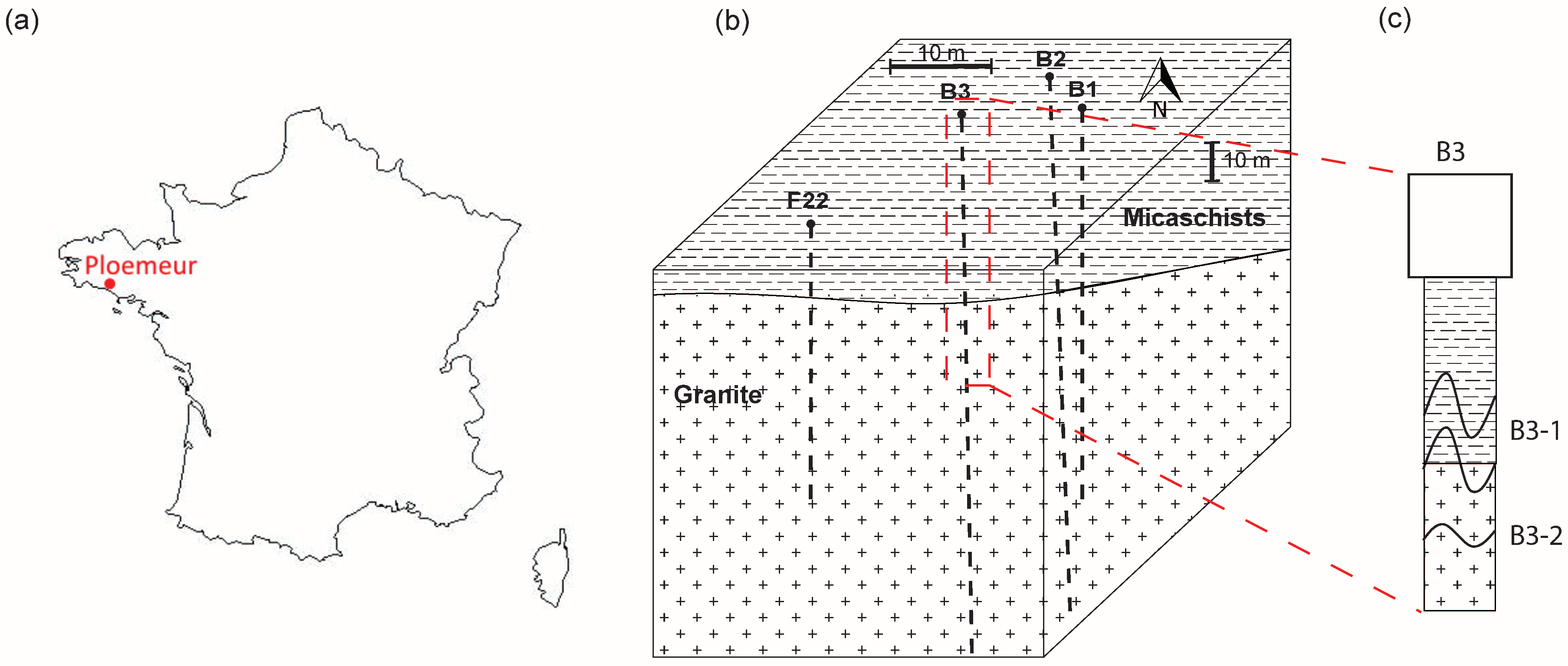
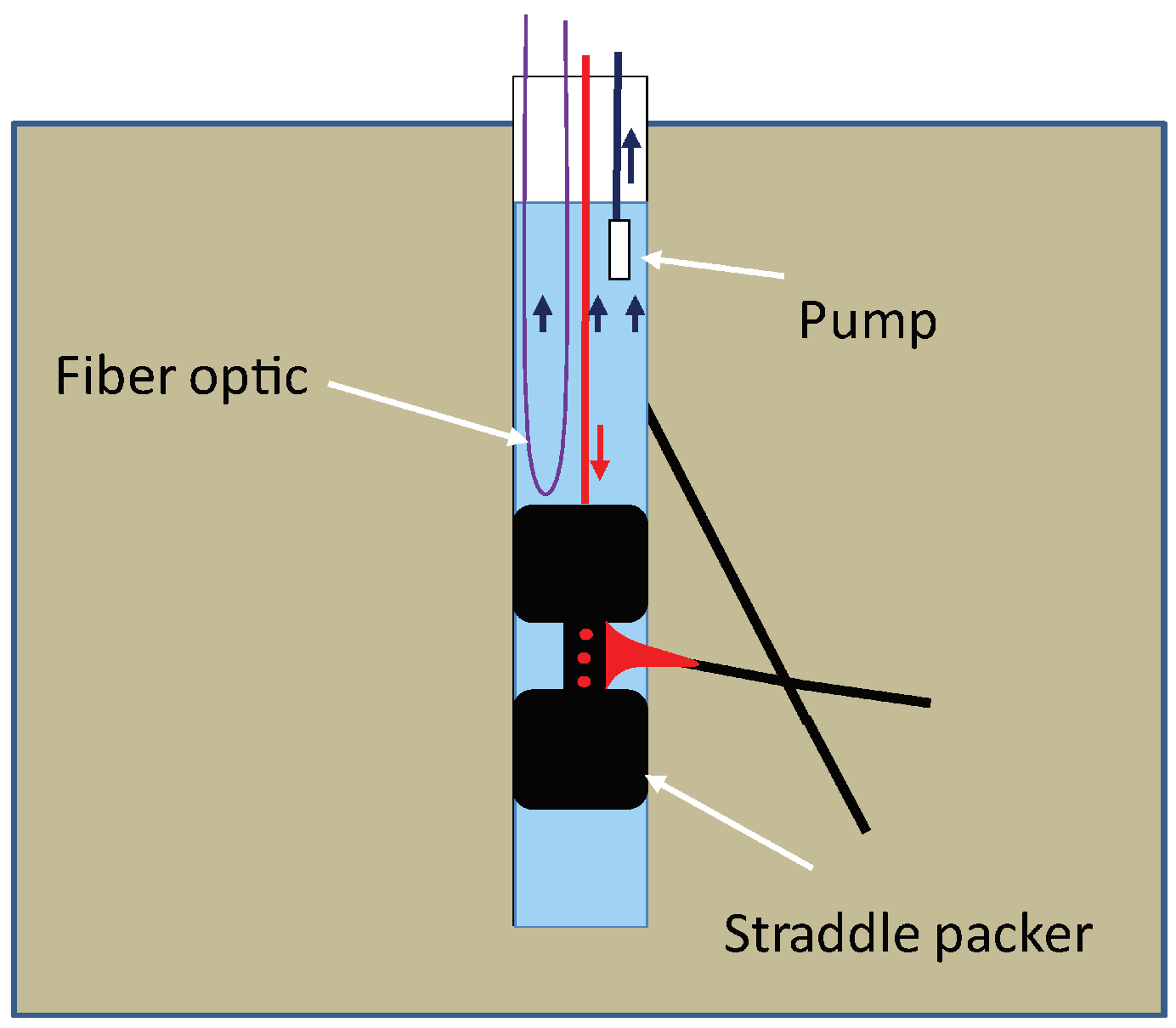
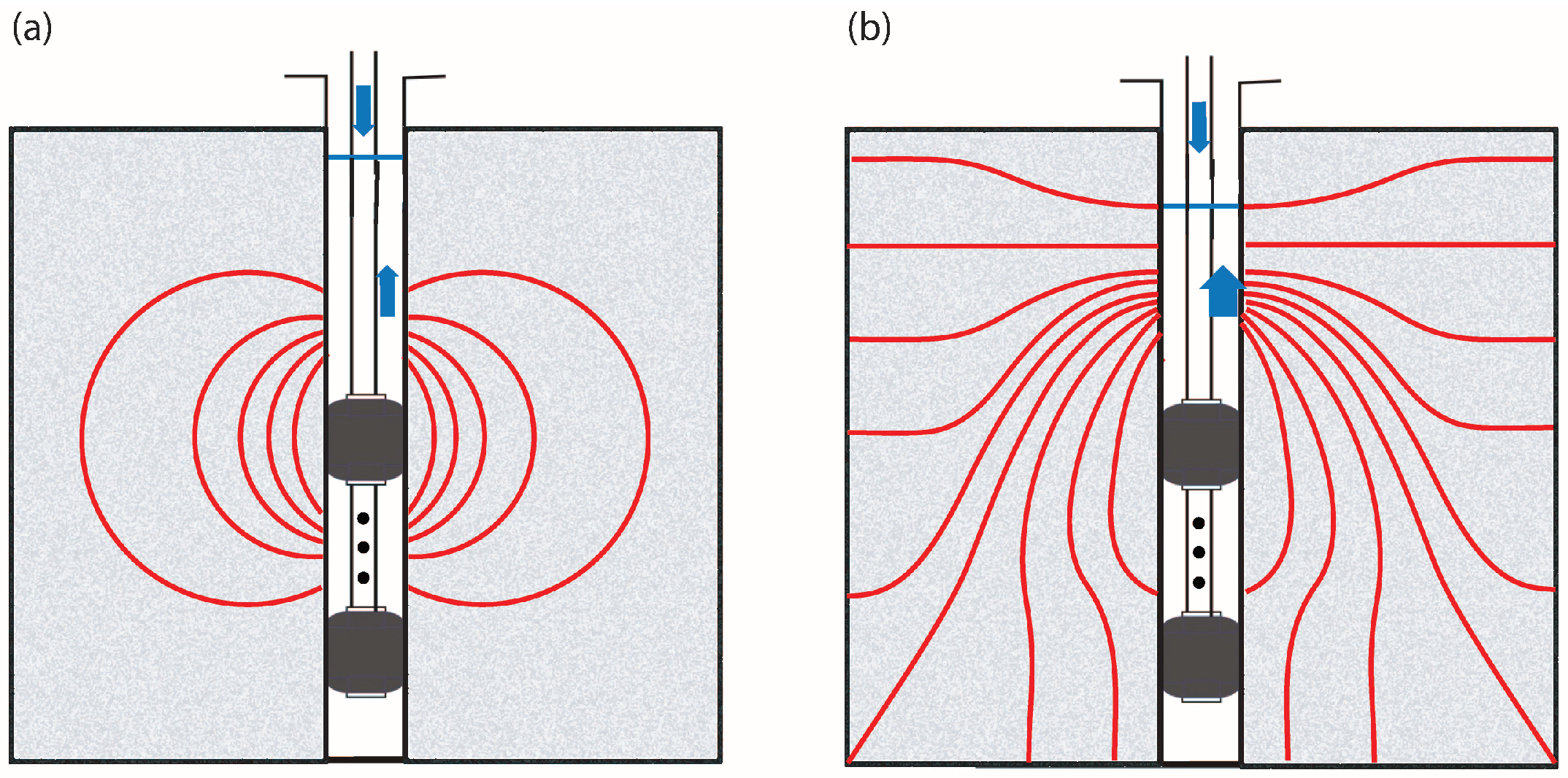
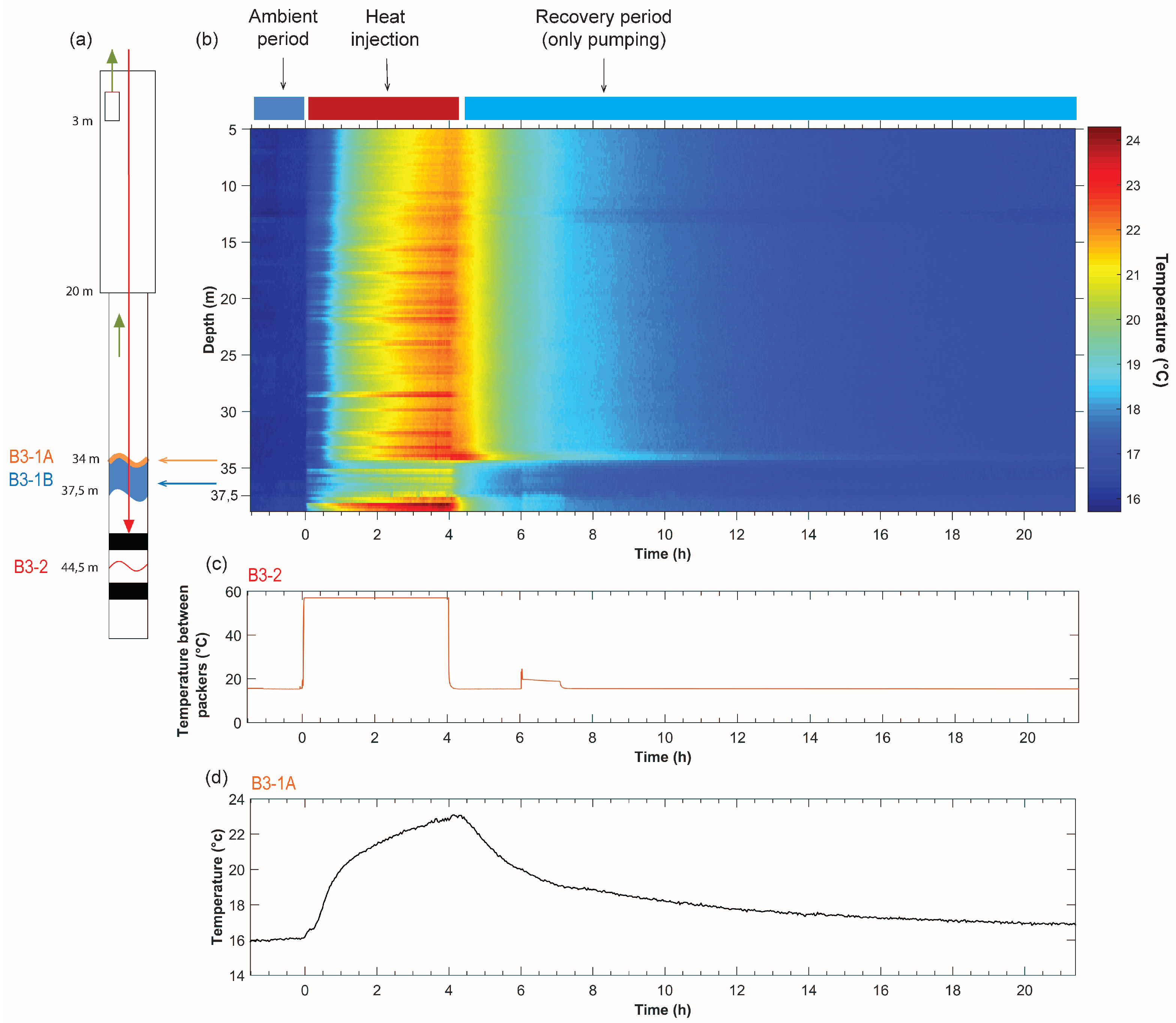
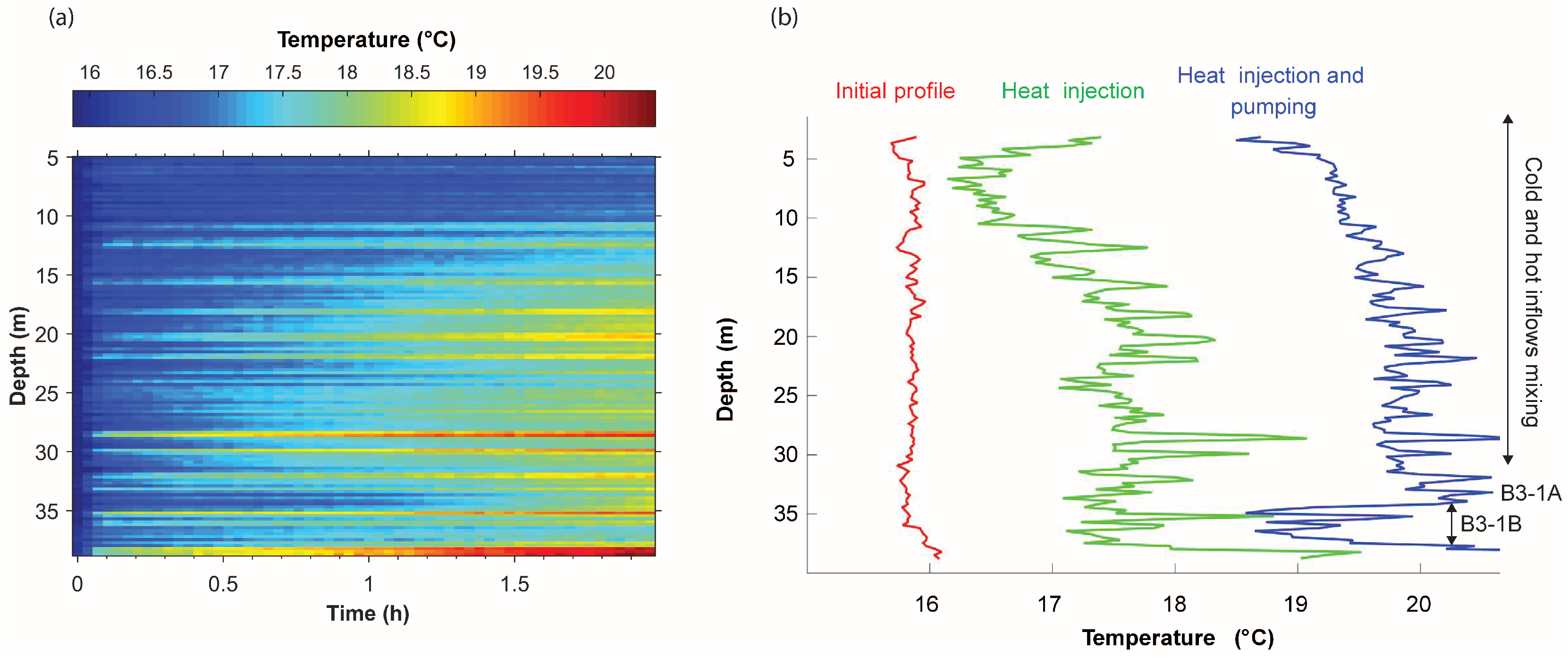
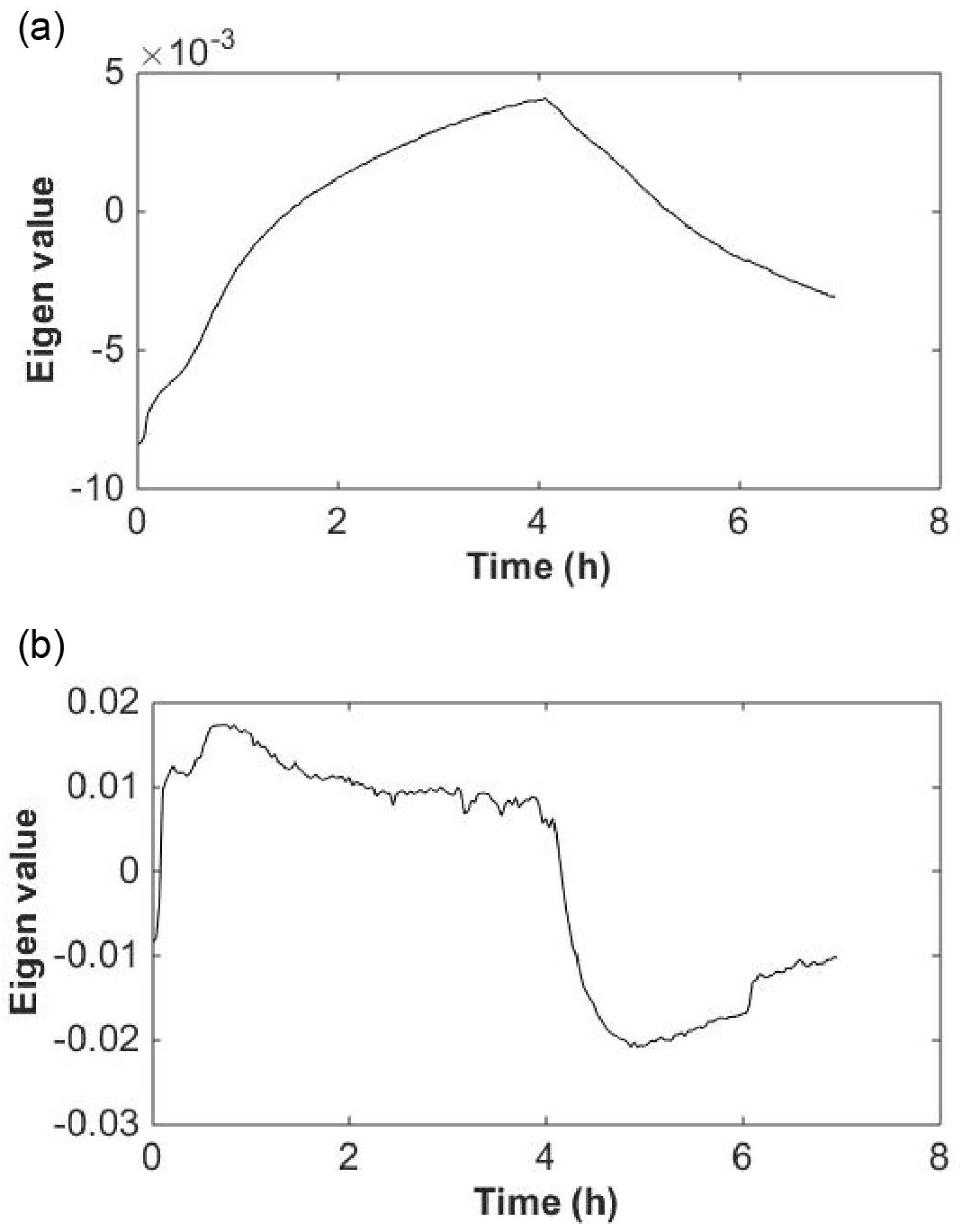
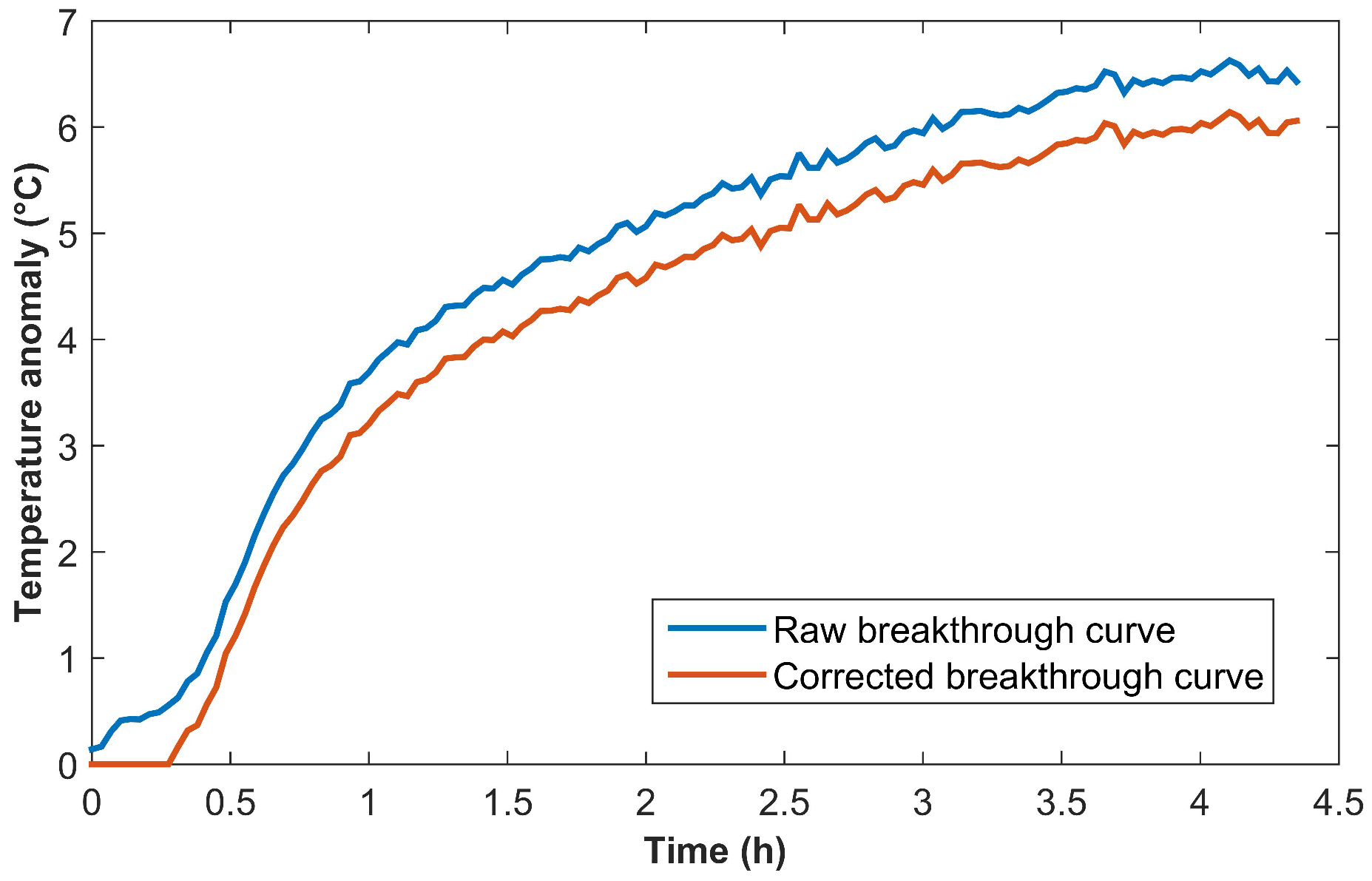
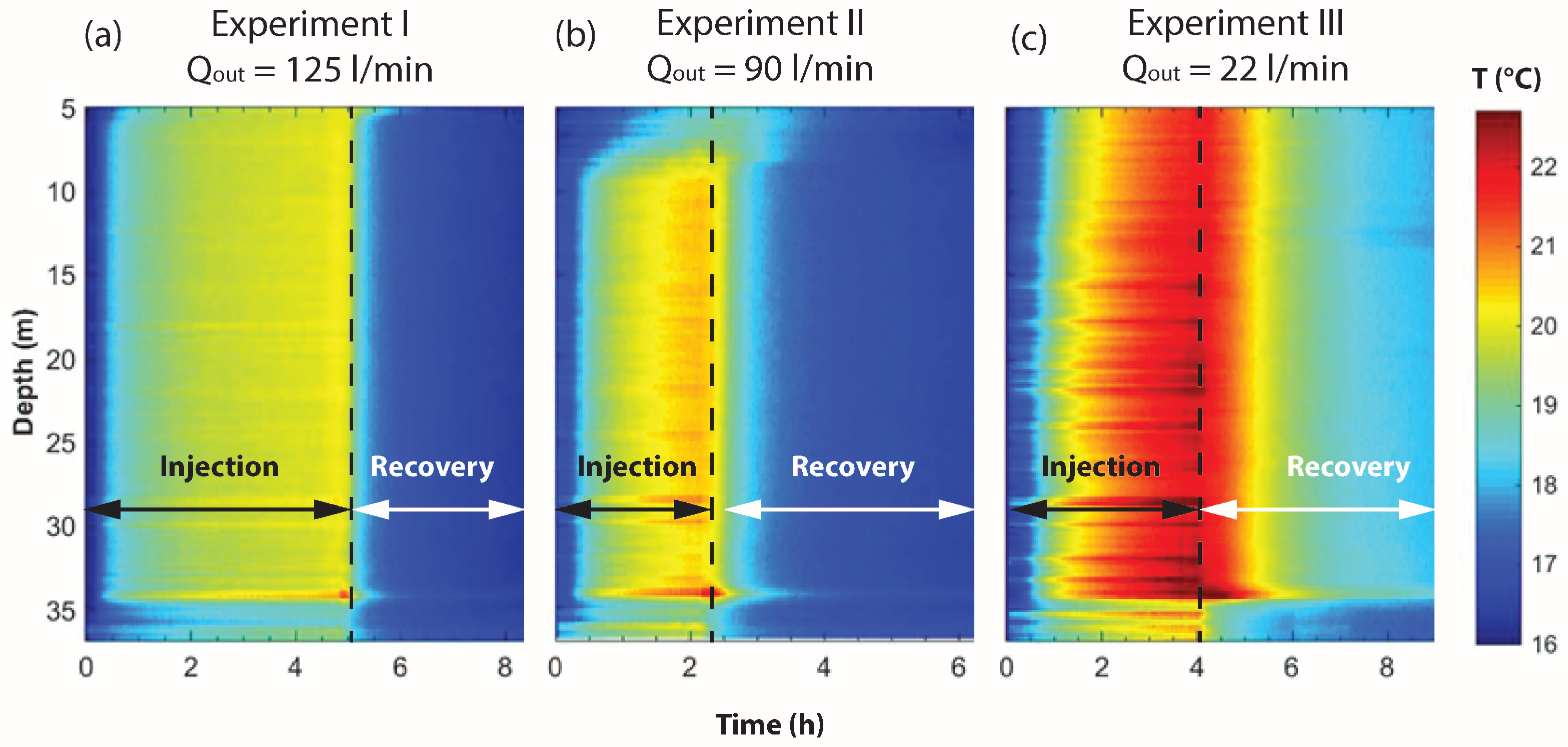
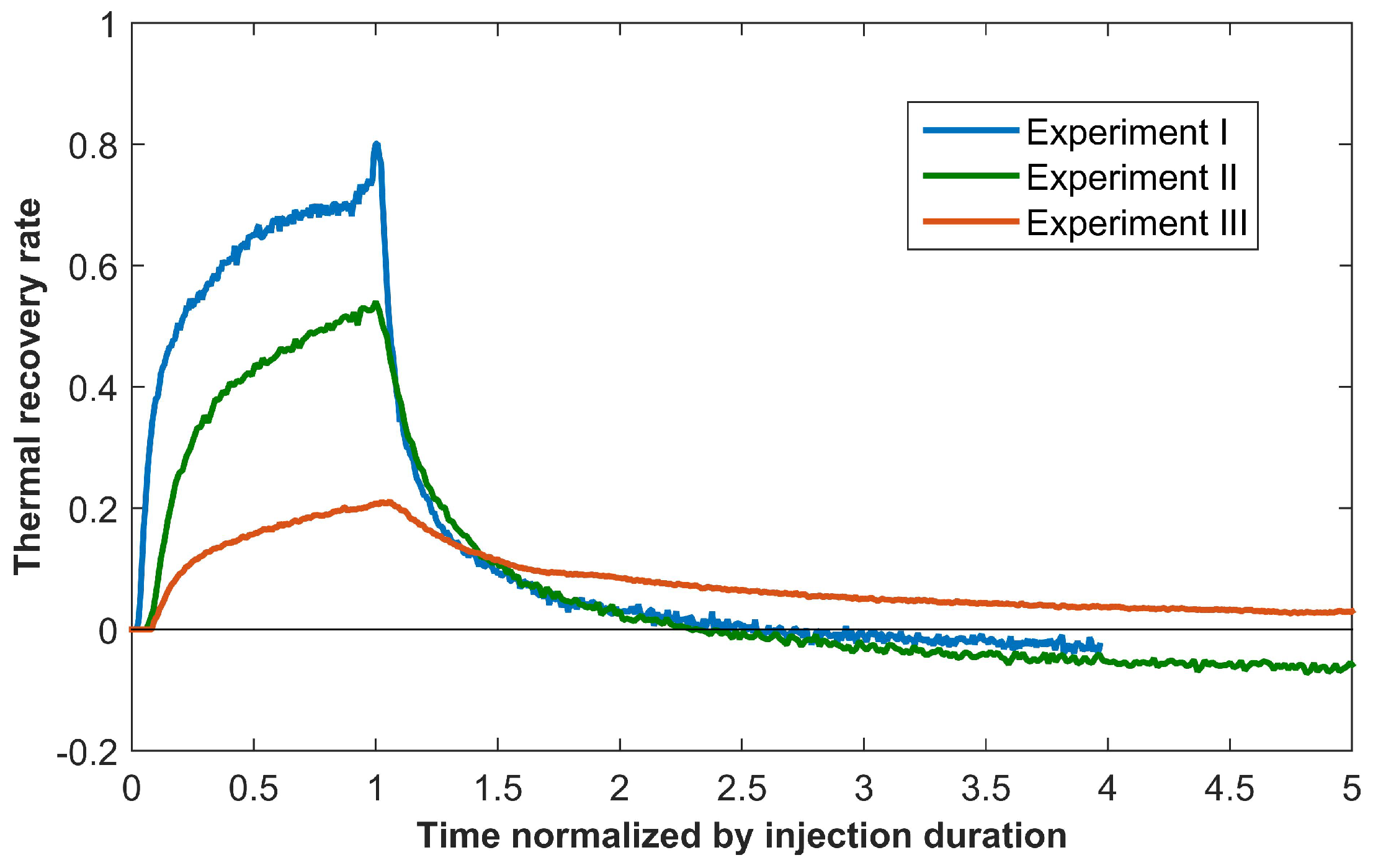
| I | II | III | IV | |
|---|---|---|---|---|
| Flow configuration | Convergent | Convergent | Perfect dipole | Divergent |
| Type of heat injection | Continuous injection | Continuous injection | Continuous injection | Continuous injection |
| Heated water injection rate | 16.2 l/min | 16.7 l/min | 16 l/min | 15.1 l/min |
| Pumping rate | 125 l/min | 90 l/min | 22 l/min | |
| Injection temperature | 57.1 °C | 55.9 °C | 56.7 °C | 50.9 °C |
| Duration of heat injection | 4 h 50 min | 2 h 10 min | 4 h 02 min | 2 h 02 min |
| Duration of heat recovery | 15 h 14 min | 13 h 10 min | 17 h 24 min |
© 2019 by the authors. Licensee MDPI, Basel, Switzerland. This article is an open access article distributed under the terms and conditions of the Creative Commons Attribution (CC BY) license (http://creativecommons.org/licenses/by/4.0/).
Share and Cite
de La Bernardie, J.; Bour, O.; Guihéneuf, N.; Chatton, E.; Longuevergne, L.; Le Borgne, T. Dipole and Convergent Single-Well Thermal Tracer Tests for Characterizing the Effect of Flow Configuration on Thermal Recovery. Geosciences 2019, 9, 440. https://doi.org/10.3390/geosciences9100440
de La Bernardie J, Bour O, Guihéneuf N, Chatton E, Longuevergne L, Le Borgne T. Dipole and Convergent Single-Well Thermal Tracer Tests for Characterizing the Effect of Flow Configuration on Thermal Recovery. Geosciences. 2019; 9(10):440. https://doi.org/10.3390/geosciences9100440
Chicago/Turabian Stylede La Bernardie, Jérôme, Olivier Bour, Nicolas Guihéneuf, Eliot Chatton, Laurent Longuevergne, and Tanguy Le Borgne. 2019. "Dipole and Convergent Single-Well Thermal Tracer Tests for Characterizing the Effect of Flow Configuration on Thermal Recovery" Geosciences 9, no. 10: 440. https://doi.org/10.3390/geosciences9100440
APA Stylede La Bernardie, J., Bour, O., Guihéneuf, N., Chatton, E., Longuevergne, L., & Le Borgne, T. (2019). Dipole and Convergent Single-Well Thermal Tracer Tests for Characterizing the Effect of Flow Configuration on Thermal Recovery. Geosciences, 9(10), 440. https://doi.org/10.3390/geosciences9100440





